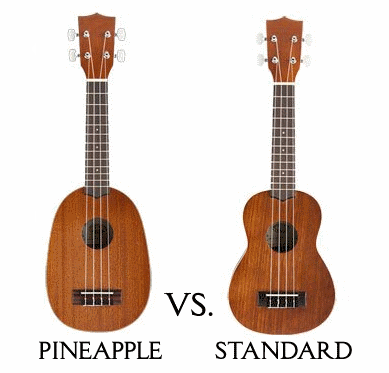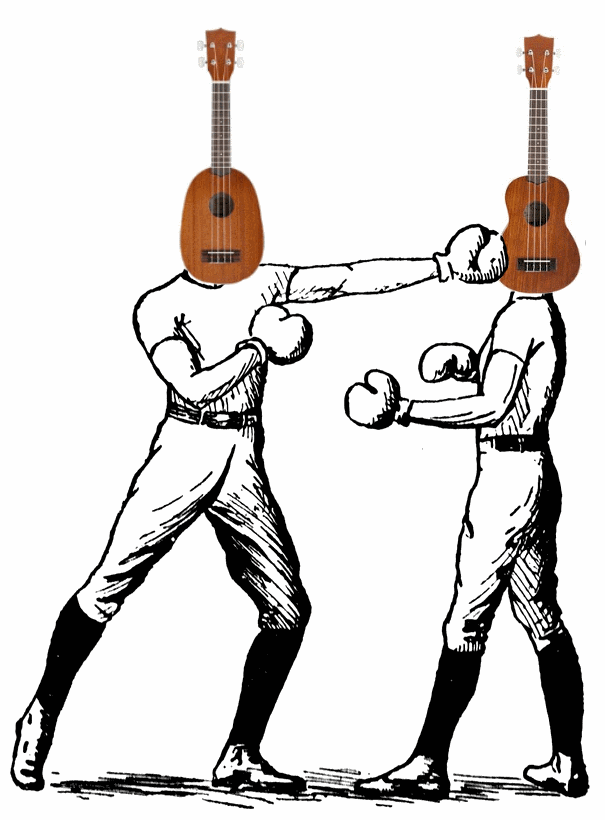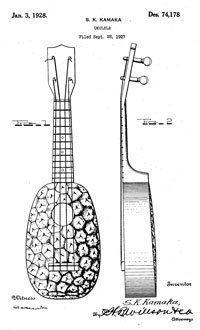
Thinking about buying a ukulele but can’t decide if you want to go with the standard, traditional, “figure eight” regular body shape or the more quirky pineapple shape?
Or maybe you’re just curious about the differences between these two styles and how they came about? Either way, buckle up and prepare for The Ultimate Ukulele Body Shape Showdown!
What is the Main Difference Between the Pineapple and Standard Ukulele Body Shapes?
The pineapple body shape ukulele is generally considered to have a louder volume and more mellow sound than a standard body ukulele of the same quality, materials, and brand. This is due to it having larger front and back panels and holding a larger amount of air in its body to resonate.

Standard Body Shape Origin
The origin of the standard “figure eight” or “guitar” body shape actually dates back to that shape being used for other guitar-like stringed instruments.

The two inward curves of the guitar body are designed to make the relatively large instrument more comfortable to play while maximizing acoustic resonance and visual aesthetics.
The bottom inward curve gives the sitting player’s thigh a “nook” to rest in, while the upper curve gives the player’s torso and strumming/plucking arm more maneuverability (similar to a cut-out style guitar/ukulele giving more maneuverability to the fingerboard hand).
Because the ukulele likely originated from the guitar/guitar-like instruments, it adopted the body shape.
Pineapple Body Shape Origin
The pineapple ukulele is generally considered to have been invented by Samuel Kaialiilii Kamaka, founder of the Kamaka Ukulele brand.
According to the story, Samuel showed his friends a new design for an oval-shaped ukulele, and his friends thought it looked like a pineapple.
I couldn’t find any information on why he originally made the oval shape in the first place. It may have been an attempt to create a more cost-efficient ukulele (see construction differences below) or a more resonant ukulele (see sound differences below), or it might have just been a fun experiment. It will have to remain a mystery for now.
Regardless, the pineapple shape caught on and Kamaka even started producing one painted with a faux pineapple texture, which he filed a patent for in 1928.

Sound & Playing Differences
Sound Differences
Because sound and playing factors are probably what most people interested in this subject are wondering about, I’ve put this section of differences first.
(I’ll be adding audio comparisons for same-brand pineapple and standard ukuleles soon, so be sure to check back.)
Most people report the pineapple body shape being louder and having a fuller, more mellow sound resonance compared to similar sized standard body shape.
This makes sense due to the pineapple body holding more volume of air to resonate, and having larger front and back panels which will vibrate more than the relatively rigid side panels, which are larger on the traditional shape.
It’s important to note that this difference applies to ukuleles of the same size, construction method/materials, wood type, strings, etc. and that ukuleles with differences in these elements might not follow this pattern.
For example: a cheaper, lesser-quality pineapple ukulele would likely not have better resonance than a more expensive, higher quality, standard body shaped ukulele.
Differences in playing
Playability wise, most people don’t report experiencing much difference in the ease or difficulty in playing either body-style over the other.
There might be a minor increase in comfort and maneuverability from the inward curves on the standard body, especially for children or small adults and with larger ukuleles (baritone or tenor).
If a guitar was shaped like a pineapple ukulele, it would likely be awkward and cumbersome to play for most people. But, because the ukulele is so small, the inward curves on the body aren’t as necessary as they are with larger instruments.
Tuning
Both instruments are tuned similarly for their respective sizes. Most commonly gCEA for soprano, concert, and tenor, and standard (non-reentrant) DGBE turning for the baritone.
Construction & Physical Comparison
Construction
The pineapple shape, though larger, actually uses less wood in its construction than standard shape ukuleles (for ukuleles of the same size).
Why? Because the “outward-then-inward” curve of the standard shape actually has more surface area than the “just-outward” curve of the pineapple shape.
Physical Portability
Physically, the standard body shape, being smaller in overall volume, might have a slight advantage in portability. It might be a tiny bit easier to pack into tight places and carry around with you, though the difference would be minimal.
Style & Aesthetic Differences
In my opinion, style-wise, the Pineapple shape can give a slightly more Hawaiian aesthetic, whereas the standard shape can look more “traditional Americana.” (Although the Banjo-Ukulele might be the ultimate “Americana” look).
I also think the pineapple shape can sometimes come off more toy-like or like a novelty item, whereas the standard shape can give a slightly more serious vibe.
In terms of Cuteness, in my opinion, the pineapple soprano uke takes the prize.
I personally prefer the standard shape stylistically, but it all comes down to a matter of taste and preference.
Availability
Ukulele Availability
Historically, the pineapple ukulele was more of a novelty and usually only available in the soprano size.
Now-a-days you can find concert, tenor and even baritone pineapple ukuleles, though the standard shape is still much more common.
Availability of Accessories
Another availability issue to consider, besides for the ukulele itself, is the availability of accessories which are body-shape specific, such as cases and bags. Generally you’ll find a much greater selection of ukulele cases and bags for the standard figure-8 body shape than the pineapple shape.

This probably won’t be an issue either way, but if you’re real picky about what case/bag you use, it’s something to consider.
Conclusion
Well there you have it. Are we any closer to determining a winner in this epic body shape battle? I’m afraid not.. but this is surely a struggle for the ages.

Thank you, you answered all the questions I had; very helpful
Happy I found this website 🙂 I didn’t think I was as curious about this as I was once I started reading. Thank you for the story, and for taking the time to write these!